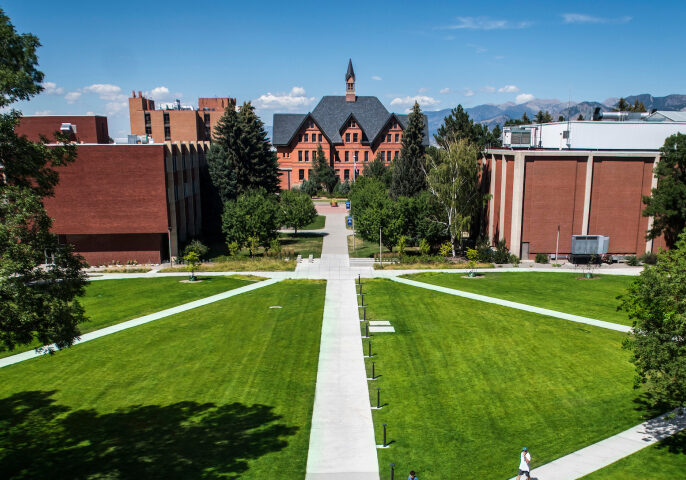Agriculture and National Security Drive MSU’s Record $289M Research Year
University's research enterprise now larger than all other Montana institutions combined, supporting over 1,400 student researchers
By Staff Writer
Sep 10, 2025
BOZEMAN — Montana State University set a new research expenditure record of $288.7 million in fiscal year 2024-25, driven primarily by agriculture and national security research that directly addresses Montana’s rural challenges and America’s defense priorities.
The College of Agriculture led all university programs with $54.1 million in research spending, while MSU MilTech, now part of the newly launched Institute for National Security Research and Education, posted a record $64.7 million in expenditures. Combined, these two areas represent over 41% of MSU’s total research enterprise.
“While we are extremely proud to have set another record in research expenditures, the heart of university research is its positive impact on our state and its people,” said Alison Harmon, MSU’s vice president for research and economic development. “The opportunities provided to students and faculty through research, as well as the economic, societal and health benefits that these projects have for our communities, are the crux of our land-grant mission.”
The 12% increase over last year’s $257.9 million total makes MSU the first and only Montana institution to surpass $200 million in research expenditures for four consecutive years. The university’s research enterprise is now larger than all other public and private universities in the state combined.
Student Opportunities Drive Economic Impact
The record expenditures supported more than 1,400 student researchers, including 654 graduate students and 803 undergraduates. Of the total spending, $14.5 million went directly to student research support, many through the Undergraduate Scholars Program.
“Our faculty and researchers are extraordinarily dedicated and talented individuals whose efforts have real, direct impact on lives and communities in Montana,” said MSU President Brock Tessman. “Additionally, seeing the research done by our students under their leadership and knowing that our graduates are prepared to continue that impact is so gratifying.”
During the 2024-25 year, MSU faculty submitted 731 funding proposals, with 525 new awards totaling $128.2 million being funded. Roughly 92% of expenditures came from competitively awarded federal grants, with the remaining 8% from private and state sources.
Agricultural Research Tackles Rural Challenges
MSU’s agricultural research leadership extends far beyond campus, addressing critical issues facing Montana’s rural communities and economy. Graduate students in the Department of Land Resources and Environmental Sciences published new findings on managing wheat stem sawflies, one of the state’s most costly agricultural pests that caused roughly $66 million in crop losses in 2024.
A team led by Michelle Flenniken studied viral infections in honeybees, working to protect Montana’s more than 250,000 honeybee colonies that are vital to the state’s agricultural economy. Meanwhile, doctoral student Giorgio Morales explored artificial intelligence applications to help farmers maximize crop yields by optimizing everything from soil nutrients to humidity management.
The College of Agriculture’s research also extends to Montana’s native ecosystems. Anna Schweiger and Danielle Ulrich used National Science Foundation funding to study carbohydrates in whitebark pine trees, examining how these stores affect the trees’ ability to withstand and recover from drought conditions.
National Security Research Expands
MSU MilTech’s record $64.7 million in expenditures reflects the university’s growing role in national security research. As part of the new Institute for National Security Research and Education, these programs address cybersecurity, defense technology, and other security priorities at both state and federal levels.
The College of Letters and Science contributed $40.6 million in research expenditures, while the Norm Asbjornson College of Engineering added $24.5 million to the university’s research portfolio.
Healthcare Reaches Rural Communities
MSU’s research impact extends directly into rural healthcare access. With a grant from the Merck Foundation, the university’s nursing college helped bring oncology services to Barrett Hospital and HealthCare in Dillon. The new infusion center, which opened in October, allows scores of rural patients to receive cancer care close to home instead of traveling over two hours to Bozeman.
The nursing college is also working to increase Montana’s number of sexual assault nurse examiners, training specialized responders who provide comprehensive care to assault victims. The program is on track to meet its goal of training 40 examiners in its first year.
Education and Community Support
A $3 million NSF grant supports dozens of science, technology, engineering and math teachers in rural and underserved areas as they pursue graduate degrees in science education. MSU Extension, with state funding, expanded support programs for unpaid family caregivers across Montana.
The Buffalo Nations Food System Initiative received funding to support Indigenous food sovereignty in the Northern Great Plains and Rocky Mountains, working to revitalize cultural knowledge and expand food system research.
Research Recognition
MSU maintains its position as one of only 104 institutions nationwide to receive both an R1 designation for “very high research spending and doctorate production” and Carnegie Classification recognition for community engagement. The university has been ranked among the top 3.7% of universities worldwide and holds the highest ranking among Montana institutions.
Other notable research includes Pat Secor’s $2.8 million grant to advance Lyme disease research, Dana Rashid’s work on inflammation and skeletal development supported by a $1 million W.M. Keck Foundation award, and Siwei He’s flood forecasting research through EPSCoR funding.
“The ripple effects from research that starts at Montana State extend far beyond our campus,” Tessman said.
Categories: Education, Technology
Don’t miss the week’s top Montana stories
Join readers across Montana who rely on WMN for independent reporting.
Unsubscribe anytime. Want to support WMN? Upgrade for $4/month →





